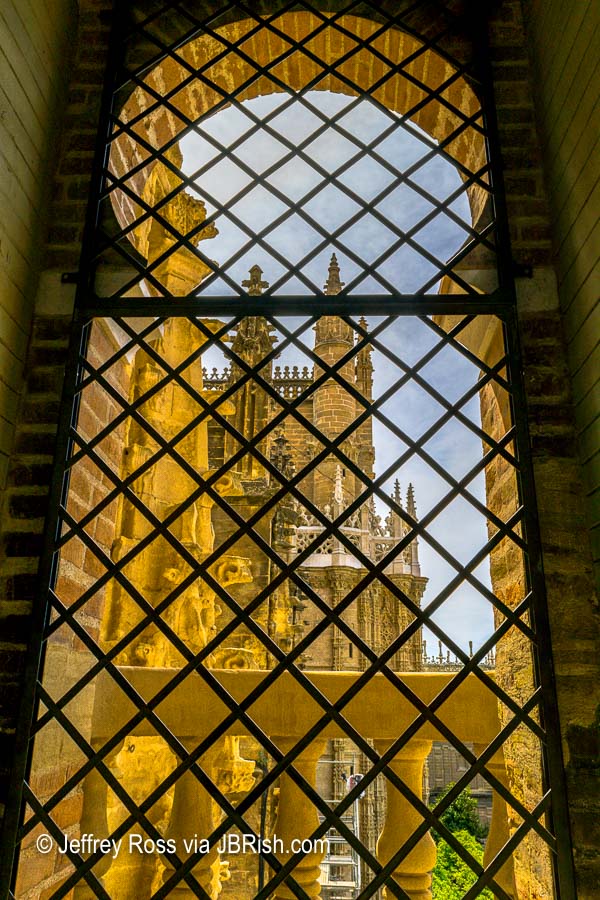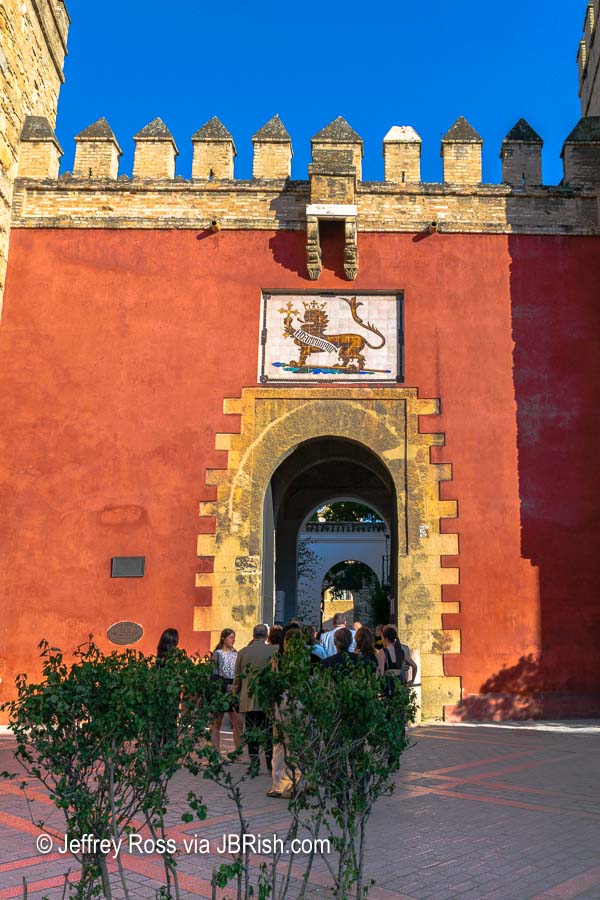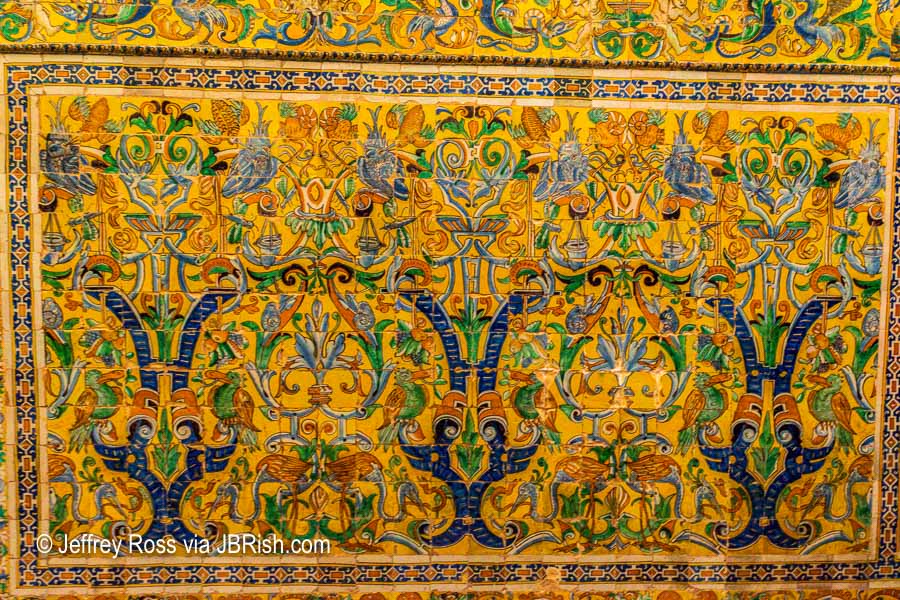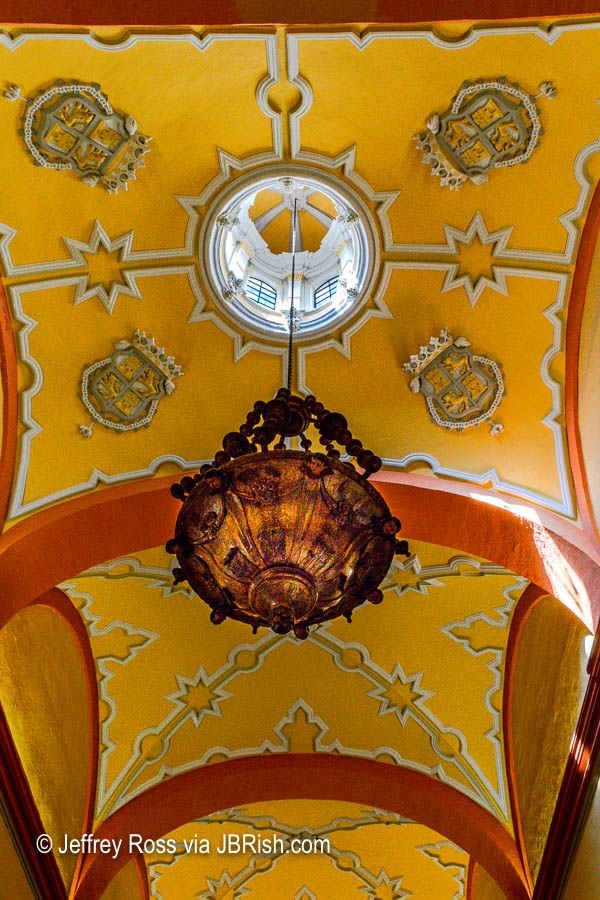Perhaps the premier tourist destination in Seville is The Cathedral of Saint Mary of the See (Seville Cathedral). The construction of this edifice lasted more than a hundred years with the intention of creating a cathedral that was magnificent beyond the imagination of the day and in that they succeeded.

Like most old landmarks, there is usually some construction or renovation being conducted at any given time. We can only be hopeful that it is nothing major when we arrive.

The Cathedral with its famed bell tower (The Giralda – pictured below) can be seen from many viewpoints near the central area of the city.

There are a number of entrances to the Cathedral. We accessed the edifice through a side entrance referred to as the Door of Forgiveness.

This basilica is the largest Gothic cathedral in the world and the third largest church overall. The ceilings were beautiful works of art and vaulted to more than 130 feet. Standing there looking upward, one can only wonder how they managed to create the detail and elegance on display.

Visitors will almost assuredly feel overwhelmed by the size of this structure. The picture below is of one of the side hallways and juxtaposes the very old holy building with the contemporary well-lit signs pointing visitors to some of the highlights.

I think it would be difficult to observe and appreciate everything there is to see in one visit. There were many people milling around and it is difficult to take photographs without the heads of the visitors seeming to adorn the bottom of the frame. We decided to focus on the highlights.
One of the beautiful altars in the Cathedral is the Altare dell’Argento or Silver Altar (of the Virgin Mary).

Another altar that was magnificent because of the ornate wood carvings, statue-filled niches and gilding was the The chapel of the Virgin of Antigua. During the period that the Cathedral was being constructed, architects tried to fill every space possible and the “fear of the void” is well demonstrated here.

The massive mahogany organ is another feature that is breathtaking in both size and exquisite detail. It would stand singularly as a work of art had it not contained the musical pipes and workings of the organ. The original organs were lost during the 1888 earthquake and subsequently replaced in 1901-03 which, in turn, have also been subsequently updated.

Read more about the organ HERE
Perhaps one of the most visited and coveted sights in the Cathedral is the Tomb of Christopher Columbus installed in 1899. The body of this noble explorer has taken several trips across the seas being held in Santo Domingo (now the Dominican Republic) and Cuba before being brought to Seville.
The tomb is a work of art with statues of four kings, each representing the kingdoms of Spain during the time Columbus was alive, hoisting high his bodily remains.


Apparently there is a dispute between where the real remains call home today. You can read about the mystery HERE
As you can see this is one of the more popular attractions within the Cathedral.

Before leaving the Cathedral, a climb to the top of the Bell Tower, accessed via a series of ramps, was warranted.

Traffic can be heavy going up and down. Adventurers will be rewarded with some excellent views of the city despite the heavily fortified vantage points. The crowds can be somewhat daunting and pushy as eager tourists jockey for the best views.


Do stop along the way to look out of the various windows and viewing nooks. Glimpses of the architecture and Cathedral structure are captivating.



Before we left the premises, we strolled through the courtyard where some children were enjoying the atmosphere as they sketched the scene before them.

You can find out more quick facts about the Cathedral HERE
Here is one more look at the exterior of the Cathedral of Seville.

On our way back to the hotel, we enjoyed this beautiful circular garden which had street performers entertaining onlookers nearby.

Next, we will say farewell to Seville with one last look around town.
**********
Read previous posts about our adventures traveling in Portugal and Spain:
Portugal – Alfama District, Lisbon Part 1
Portugal – Alfama District, Lisbon Part 2
Portugal – Lisbon Streets & Garden
Lisbon Portugal – The Belem and Tejo River District
Sintra Portugal – National Palace and Quaint Streets
Portugal – Seaside Resort of Cascais
Portugal – Lisbon’s Edward VII Park
Lisbon, Portugal – Walking the Avenue to the Rossio District
Lisbon, Portugal – Unique Gift Shop
Portugal – Evora’s Capela dos Ossos
Merida, Spain – Ancient Roman Ruins
Seville, Spain – First Impressions
Seville, Spain – Around Town (Sights along the streets)
Read more Hiking and Exploration posts HERE
**********
All original content on this blog is copyrighted by Jeffrey B. Ross with ALL Rights Reserved. While reference links back to JBRish.com are appreciated and encouraged, please acquire approval for any reproduction of original content from this website.
©Jeffrey B. Ross 2014 – 2019 – JBRish.com





























